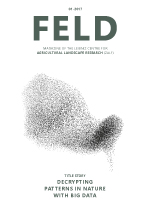Page Content

Released: January 20th, 2017
The complete issue is available for download:
Feld 1/2017 PDF (ca. 5 MB)
Decrypting patterns in nature with BIG DATA
MyTitle: Decrypting patterns in nature with BIG DATA
MyLinkAnsehenUrl:
MyLinkPDFUrl:
MyTitelMehrzeilig:
MyTextfeld: <div class="ExternalClassDCFF17E17ADA4F7499C1C1138ED1D0EF"><p>Researchers have spent 20 years gathering an enormous wealth of data in a study area in Brandenburg covering approximately 160 km²: sensors measure data in the soil, groundwater and the air, but also observations of animals and studies of plants can help us better understand interactions in the environment. Previously, linking and correctly interpreting the data proved extremely difficult due to the enormous complexity as well as the sheer quantity of data – statements about natural correlations remained vague. An excursion into theoretical physics led a team of researchers to a new methodology and then to a discovery: patterns in the sea of data.<br><br><a title="Read the whole article" href="/en/aktuelles/Feld-Magazin/1-2017/Pages/Big-Data.aspx">Read more ...</a></p></div>
MyAutoren:
MyMeldungsdatum:
MyLabels:
Struktureinheiten:Label:
NewWindow:
MyEbene: 1
MyKategory:
Decrypting patterns in nature with BIG DATA
Researchers have spent 20 years gathering an enormous wealth of data in a study area in Brandenburg covering approximately 160 km²: sensors measure data in the soil, groundwater and the air, but also observations of animals and studies of plants can help us better understand interactions in the environment. Previously, linking and correctly interpreting the data proved extremely difficult due to the enormous complexity as well as the sheer quantity of data – statements about natural correlations remained vague. An excursion into theoretical physics led a team of researchers to a new methodology and then to a discovery: patterns in the sea of data.
Read more ...
United for species protection
MyTitle: United for species protection - from the field to the shop counter
MyLinkAnsehenUrl:
MyLinkPDFUrl:
MyTitelMehrzeilig:
MyTextfeld: <div class="ExternalClassBF6C192D9CD944188999851D55B6E49D"><p>Around 28,000 animal and plant species worldwide are classified as endangered. An issue we are also increasingly encountering on domestic meadows and fields. For wherever land is intensively cultivated, less space remains for segetal flora, farmland birds and insects. In the „Agriculture for Biodiversity« pilot project, scientists are now linking the competitiveness of farmers to nature conservation and are receiving support from one of the largest food retailers in Germany.
<br><br> <a title="Read the whole article" href="/en/aktuelles/Feld-Magazin/1-2017/Pages/artenschutz.aspx">Read more ...</a></p></div>
MyAutoren:
MyMeldungsdatum:
MyLabels:
Struktureinheiten:Label:
NewWindow:
MyEbene: 1
MyKategory:
United for species protection - from the field to the shop counter
Around 28,000 animal and plant species worldwide are classified as endangered. An issue we are also increasingly encountering on domestic meadows and fields. For wherever land is intensively cultivated, less space remains for segetal flora, farmland birds and insects. In the „Agriculture for Biodiversity« pilot project, scientists are now linking the competitiveness of farmers to nature conservation and are receiving support from one of the largest food retailers in Germany.
Read more ...
Science as development aid
MyTitle: Science as development aid: India undergoing (climate) change
MyLinkAnsehenUrl:
MyLinkPDFUrl:
MyTitelMehrzeilig:
MyTextfeld: <div class="ExternalClass5BE30957B89D4C33AD1F202CAD7EBEDC"><p>Extreme droughts have long threatened the lives of small farmers in the state of Odisha in India. In recent years, however, the number of natural disasters has increased. Science can play an important role to help those affected on site better able to help themselves. As part of a working group located in Müncheberg in Brandenburg, Indian doctoral student Anu Susan Sam is looking for solutions for one of the worst affected regions in India.
<br><br>
<a title="Read the whole article" href="/en/aktuelles/Feld-Magazin/1-2017/Pages/Klimawandel-Indien.aspx">Read more ...</a></p></div>
MyAutoren:
MyMeldungsdatum:
MyLabels:
Struktureinheiten:Label:
NewWindow:
MyEbene: 1
MyKategory:
Science as development aid: India undergoing (climate) change
Extreme droughts have long threatened the lives of small farmers in the state of Odisha in India. In recent years, however, the number of natural disasters has increased. Science can play an important role to help those affected on site better able to help themselves. As part of a working group located in Müncheberg in Brandenburg, Indian doctoral student Anu Susan Sam is looking for solutions for one of the worst affected regions in India.
Read more ...
The farmers of the neolithic
MyTitle: The farmers of the neolithic
MyLinkAnsehenUrl:
MyLinkPDFUrl:
MyTitelMehrzeilig:
MyTextfeld: <div class="ExternalClassB014ECAFF6E040D2B61B4DAB2CD0EF3B"><p>How did people grow their food 5000 years ago? In search of answers, Brandenburg scientists have travelled through time with the aid of computer simulations and made amazing discoveries.
<br><br>
<a title="Read the whole article" href="/en/aktuelles/Feld-Magazin/1-2017/Pages/archaeologie.aspx">Read more ...</a></p></div>
MyAutoren:
MyMeldungsdatum:
MyLabels:
Struktureinheiten:Label:
NewWindow:
MyEbene: 1
MyKategory:
The farmers of the neolithic
How did people grow their food 5000 years ago? In search of answers, Brandenburg scientists have travelled through time with the aid of computer simulations and made amazing discoveries.
Read more ...
Interview: Prof. Dr. Frank Ewert
MyTitle: Interview: Prof. Dr. Frank Ewert
MyLinkAnsehenUrl:
MyLinkPDFUrl:
MyTitelMehrzeilig:
MyTextfeld: <div class="ExternalClass249BEE9CEC5A48FAAC411C0DEDB1E721"><p>Climate change. Food security. Sustainability. </p><p>An interview with Prof. Dr. Frank A. Ewert, Scientific Director of the Leibniz Centre for Agricultural Landscape Research (ZALF)
<br><br><a title="Read the whole article" href="/en/aktuelles/Feld-Magazin/1-2017/Pages/Interview.aspx">Read more ...</a></p></div>
MyAutoren:
MyMeldungsdatum:
MyLabels:
Struktureinheiten:Label:
NewWindow:
MyEbene: 1
MyKategory:
Interview: Prof. Dr. Frank Ewert
Climate change. Food security. Sustainability.
An interview with Prof. Dr. Frank A. Ewert, Scientific Director of the Leibniz Centre for Agricultural Landscape Research (ZALF)
Read more ...
